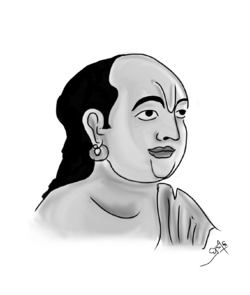Baladeba Ratha
Kabisurjya Baladeba Ratha (alternatively spelled Kabisurya, Kavisurya Baladev Rath, Odia: କବିସୂର୍ଯ୍ୟ ବଳଦେବ ରଥ; c. 1789 – 1845) was an Odia poet, eminent composer and musician of Odissi music. He wrote in both Sanskrit and Odia. His works are known for devotional quotient. He is the credited founder of the Dhumpa Sangita.[1] Kabisurjya has composed hundreds of songs in the tradition of Odissi music, employing traditional ragas & talas unique to Odissi. His magnum opus Kisorachandrananda Champu is a cornerstone of the Odissi music repertoire & Kabisurjya is widely renowned for his masterful compositions.
Kabisurjya Baladeba Ratha | |
|---|---|
 | |
| Native name | କବିସୂର୍ଯ୍ୟ ବଳଦେବ ରଥ |
| Born | Bada Khemundi, Ganjam, Odisha, India |
| Died | Athagada, Odisha, India |
| Language | Odia |
| Nationality | Indian |
| Citizenship | India |
| Genre | Odissi music |
| Notable works | Kishorachandrananda Champu, Ratnakara Champu, Chandrakala, Sarpa Janana |
Early lifeEdit
He was born in Bada Khemundi (presently Digapahandi), Ganjam, Odisha. Baladeva Ratha's mother died when he was ten years old. He was brought up by his maternal grand father, Tripurari Hota in Athagada (who also taught him Sanskrit and Odia literature). He married at the age of 15. After his father's death, he moved to the nearby Jalantara state. The prince of Jalantara, Rama Chandra Chhotaraya encouraged his literary creations and gave him the title 'Kabisurjya', meaning 'The Sun among Poets.'
Literary worksEdit
File:Janana Baladeba Ratha (Odia).oggRatha was an Odissi musician and scholar. He composed poems as a Vaishnava, in devotion to Lord Vishnu. He was associated with a group of poets, which included Dinakrushna Dasa and Abhimanyu Samantasinghara.[2] His best-known works include Kabisurjya Granthavali, Kabisurjya Geetabali and Kisora Chandrananda Chaupadi-Chautisa, which combines the two literary forms of chaupadi (a poem having four stanzas (though the term came to refer to any short song in latter times), and chautisa (a 34-stanza poem where every stanza begins with a new letter of the Odia alphabet). Kisora Chandrananda Champu is noted for its emotional quotient and the role it played in enforcing the riti school of Sanskrit literature. He was also the author of several champus including Ratnakara Champu, Premodaya Champu and Kisora Chandrananda Champu.[3][4] Kisora Chandrananda Champu has both Odia and Sanskrit compositions and it was the Odia part of the work that has been credited with cementing his literary reputation in the language.[2]
Dhumpa sangitaEdit
Ratha is thought to have invented the dhumpa, a bamboo percussion instrument, that accompanies the Odia folk art form of dhumpa sangita. The dhumpa accompanies recitations of his songs called dhumpa sangeeta.[5][6] Many of his poetic pieces, especially the champu are set to dance in Odissi.[7][8][9]
Death and CommemorationEdit
Ratha died in Athagada (Athgarh, Odisha) in the year 1845.[3] Dasarathi Das' Kabisurjya Baladeba Ratha is a biography that examines his life and contributions to Indian literature.[10] Kabisuryanagar, formerly Boirani, a town in the Ganjam district of Odisha has been named in his honour.[11]
ReferencesEdit
- ↑ Garg, Ganga Ram (1992). Encyclopaedia of the Hindu World: A-Aj, Volume 1. New Delhi: Concept Publishers. p. 78. ISBN 9788170223740.
- ↑ 2.0 2.1 Nagendra (1988). Indian Literature. Delhi: Prabhat Prabhashan. p. 454.
- ↑ 3.0 3.1 "EMINENT LITERARY LUMINARIES OF ORISSA" (PDF). Orissa Reference Annual: 292. 2004. Archived from the original (PDF) on 19 October 2013. Retrieved 27 March 2013.
- ↑ Das, Sisir Kumar (1991). A History of Indian Literature: 1800–1910 : Western Impact, Indian Response. New Delhi: Sahitya Akademi. pp. 55, 374. ISBN 9788172010065.
- ↑ "Call to revive folk musical instrument 'Dhumpa'". The Hindu. 17 December 2007. Archived from the original on 19 December 2007. Retrieved 27 March 2013.
- ↑ "Gopalpur beach fest gets under way". The Hindu. 26 December 2010. Retrieved 27 March 2013.
- ↑ "Camping with concepts". The Hindu. 8 June 2012. Retrieved 27 March 2013.
- ↑ "Their spot in the sun". The Hindu. 13 December 2012. Retrieved 27 March 2013.
- ↑ "Odissi takes centrestage". The Hindu. 18 August 2006. Archived from the original on 28 September 2013. Retrieved 27 March 2013.
- ↑ Dasarathi Das (1987). Kavisurya Baladeva Rath. Sahitya Akademi.
- ↑ "Kabisuryanagar". Retrieved 27 March 2013.